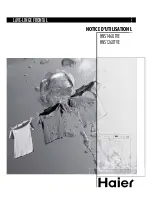
page EN-5
Safety
■
Consult a doctor immediately if the
child has been exposed to detergent
in their mouth.
If the automatic door opening (de-
pending on the model) displays a fault,
children may get injured.
■
Keep children away from the opening
area of the appliance door.
CAUTION
Risk of injury!
Children and certain groups of people
have a higher risk of being injured when
handling the appliance.
■
This appliance can be used by chil-
dren aged 8 years and older and per-
sons with reduced physical, sensory
or mental capabilities or lack of ex-
perience and knowledge if they have
been given supervision or instruction
concerning the use of the appliance
in a safe way and understand the
hazards involved.
■
Do not allow children to play with the
appliance.
■
Cleaning and user maintenance shall
not be made by children without su-
pervision.
Risks in handling household
electrical appliances
WARNING
Risk of electric shock!
Touching live parts may result in severe
injury or death.
■
Only use the appliance indoors. Do
not use in wet rooms or in the rain.
■
Do not operate or continue to oper-
ate the appliance if
–
it exhibits visible damage, e.g. the
connector cable is defective, the
control panel is cracked, or the ap-
pliance function is impaired.
–
It starts smoking, or there is a smell
of burning.
–
it makes unfamiliar noises.
In these cases, you should pull the
mains plug out of the socket or switch
off/unscrew the fuse and have the
appliance repaired (see “Service” on
page EN-40).
■
The appliance corresponds to pro-
tection class I and may only be con-
nected to a socket with a protective
conductor that has been installed
properly. Ensure that the voltage is
correct when connecting it. More de-
tailed information about this can be
found on the nameplate.
■
If the mains plug is no longer acces-
sible after connecting it, an all-pole
disconnecting device complying with
overvoltage category III must be con-
nected into the house wiring with a
contact gap of at least 3 mm; consult
a qualified professional if necessary
(see “Service” on page EN-40).
■
We recommend using a pulse-sensi-
tive residual-current device (RCD).
















































